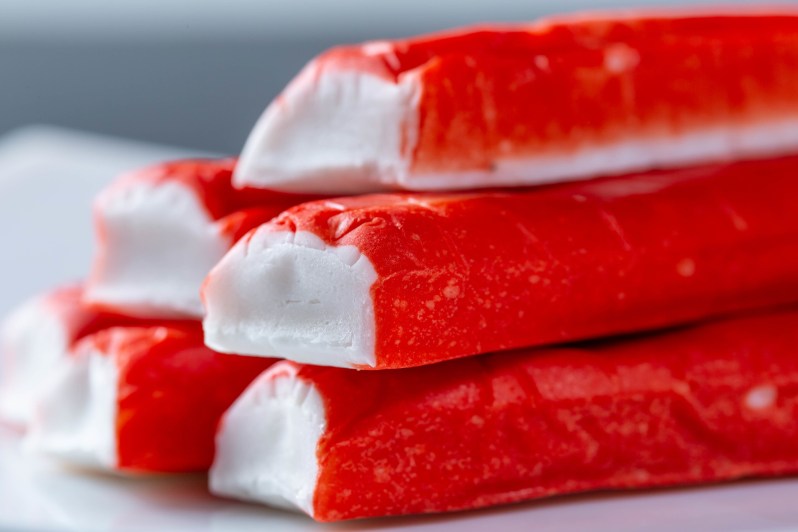
You’ve probably eaten your fair share of imitation crab meat, whether you realize it or not. Over the last few decades, this fishy imposter has greedily taken over many of our otherwise favorite foods. Dishes like crab cakes, sushi rolls, and the ever-popular deep-fried crab rangoon can no longer be trusted to contain our pinchy little ocean friends. Instead, these foods are most likely infused with surimi, an ocean imposter masquerading as a crab.
Of course, in an ever-changing world of new foods and culinary substitutions, it’s important to look at imitation crab through a judgment-free lens. After all, there are plenty of beautiful plant-based meats on the market. And where would be be without the plethora of soy and nut milks offered to us in the grocery store refrigerator? Any one particular food should not be discriminated against simply because it has evolved. So, where does that leave imitation crab?
What is imitation crab?

Imitation crab is made primarily from surimi. You may have seen this word on a menu and, like many, thought that surimi was a certain variety of fish. What surimi actually is, though, is a paste made from a mixture of pulverized fish such as Alaska pollock, Atlantic cod, haddock, and/or hake. Surimi generally comprises roughly 35% – 50% of imitation crab, with added fillers such as water, starch, sugars, oils, salt, and proteins like soy making up the remainder of the product. Generally speaking, there is absolutely no real crab in the mix, aside from a small amount of crab extract – a product made from boiling, baking, and pulverizing actual crab – that can be added for flavor.
To really wrap your mind around the concept, you might think of imitation crab as the hotdog of the seafood world – a hodgepodge of various fish bits and flavorings all pressed into a cylindrical tube of a processed food product. Yum.
How is imitation crab made?

Sticking with our hotdog comparison, sometimes it’s better not to know how “the sausage gets made.” There are some things that the mind’s eye just can’t un-see. But for the truly (perhaps morbidly) curious at heart, this TikTok gives a three-minute rundown of the whole imitation crab-making process. Proceed with caution.
After the fish is minced and pressed into a paste (surimi), it is heated, blended with fillers, heated again, and then pressed into shapes that just ever-so-slightly resemble authentic crab meat….if you squint. These pieces are then vacuum-sealed and pasteurized before being shipped off to their respective buyers and distributors.
How is imitation crab used?

Imitation crab comes in many forms and can be found in most grocery stores’ refrigerated and frozen sections. Flakes, chunks, sticks, and shreds are all popular varieties used in countless preparations. Since the product is precooked, it can be eaten straight from its package or tossed directly into any dish, cold or hot.
Because imitation crab is so much cheaper than real crab, it’s a popular choice for mixtures where it might camouflage itself and pass as the real deal. Crab cakes, sushi rolls, dips, spreads, and soups are common places where it might be used. Of course, some people embrace the product for what it is and serve it atop salads or other dishes where it shines in all its processed fraudulent glory.
What are the pros and cons of eating imitation crab?

In the interest of fairness, it’s essential that we consider both the pros and cons of imitation crab meat.
Cons
With overly processed foods, there are times to just go ahead and indulge. Damn the consequences, life is short, and all of that, right? Consider our friend the hotdog. Is it processed to oblivion, filling our bodies with unknown chemicals and god knows what else? Yes. But is it delicious? Also yes. So we feign ignorance and look the other way for the sake of flavor, nostalgia, baseball games, and backyard barbecues.
Now, take imitation crab. Is it also processed and, frankly, a bit strange? Yes. But is it delicious? No. Honestly, it’s pretty gross. We understand that a product that tastes like a crab with such a smaller price tag would be alluring. The problem is that imitation crab tastes nothing like the real thing. If it’s crab you’re craving, it’s far better just to loosen the purse strings and buy the real deal.
In addition to its lackluster flavor, imitation crab meat is far from a sustainable product. The overfishing of pollock – the most common fish used in surimi – has had a considerable impact on the environment, endangering animals like sea lions, fish, and seabirds that need pollock for their own survival.
Pros
It’s cheap. That’s it. That’s the whole list.



